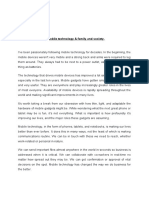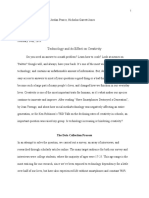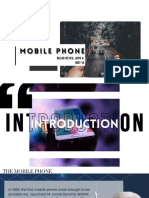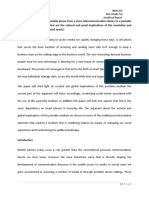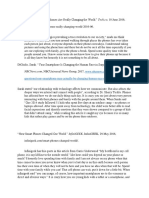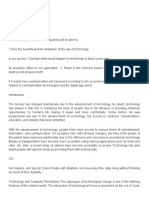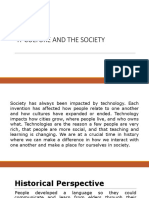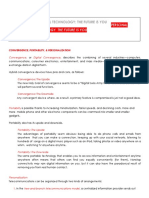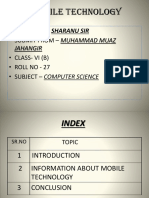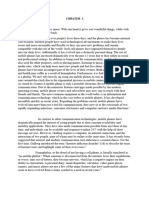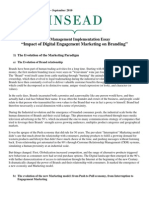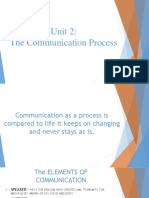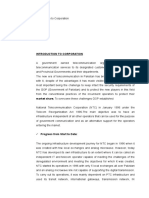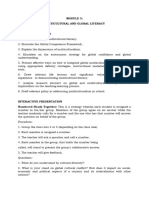The mobile phone; an indispensible part of our lives. But does it hold/ encourage/ embody creative production potential?
HISTORY The technology of the mobile phone has quickly developed from a HISTORY bulky single purposed handset, once confined to members of an wealthy class to ultra thin, multi functional devices reaching across class, race and age and a device today held by individuals in all corners of the world. The development of such a device was the brain child of Martin Cooper and his team at Motorola, following years of research and studies into the practicality of such an invention, issues of weight, size and transmission frequency were in seemingly overcome when he developed the first handheld in 1983. A commercially available cell phone - the Motorola DynaTac 8000x. At 13 inches long and weighed two and half pounds, it was on the market for $4000 (2600). "The battery lifetime was 20 "The battery lifetime was 20 minutes, but that wasn't really a big problem because you couldn't hold that phone up for that long." Martin Cooper explained that he had intended for his invention to help people, with a dream that one day everyone would own such a device, "In fact we had a joke that said 'in the future, when you were born you would be assigned a telephone number and if you didn't answer the phone, you were dead'.
minutes, but that wasn't really a big problem because you couldn't hold that phone up for that long." Martin Cooper BBC article 2007
"In fact we had a joke that said 'in the future, when you were born you would be assigned a telephone number and if you didn't answer the phone, you were dead'.
Just over 30 years later and we are well on our way to fulfilling his dream of world ownership of such a device. With a world population of approx. 6.5 billion people, two thirds of whom now own a mobile phone. Satellite signals, and decreased manufacturing costs have brought us to the current place of mobile phone ownership as central to society. DATA According to a recent survey by Ofcom 2011 92% of adults own a mobile phone Over a quarter of adults (27percent) and almost half of teenagers (47 percent) now own a smartphone So from establishing that the mobile phone device has become an integral aspect of social culture, I wish to look more closely at the how the functionality has changed and the potential of creative practice that this may bring. TECHNOLOGICAL CONVERGENCE When first invented a mobile phone was merely a phone unconfined to a location, but in 30 years they have become a device central to social being and for whom the next generation
Convergence, the flow of content across multiple media platforms Technological convergence that all devices could converge into one central device that did everything for you.
Data as text floats across screen, Ofcom 2011 Communication Survey
�depend so strongly on. A multi functional, wireless source of communication allowing owners to capture every moment in a video or a picture, and to be in touch 24/7. The expanding size of the screens and the introduction of functions such as texting, network messaging, games, calendars, and clocks have made this device a converged piece of media. But it the functions which allow the individual to capture and create which I am focusing on. The video camera, still camera and more recently ability to sharing what you create with internet access on many mobile phone. New Generation Marc Prensky describes the young generation as digital natives, individuals for whom this new converged pocket technology is undaunting and infact natural. I wish to explore to what extend the digital natives are creative natives and if the technology in their pocket encourages creative practice in them.
IMAGES of phones
FLOATING QUOTES
thumb generation Brooke 200 2 digital native Prensky net generation Buckingham
As Prensky points out, crossing the line of digital immigrant to digital native means shifting our focus from the technology to the skills which this technology brings. Prensky The emerging online life of the digital native.
OFCOM 2011 Almost half of those asked said they used the video camera and cameras on their phone often, but to create and capture what? I wonder though if perhaps these digital natives are so comfortable with the technology in their pockets that they lack the ability to seek creative potential.
Pause It is undisputed that mobile phone video footage and pictures have become more and more common as an acceptable window of information. Used not just to capture memories for personal consumption but indeed moments which are then shared by millions, and more often now as an essential and immediate tool in capturing authentic footage of events such as natural disasters and war zones. The video and camera function have undoubtedly contributed to the creation of a participatory culture THE DEBATE When exploring how technology and its functions can evoke creativity in individuals we are faced with the theoretical debate of technological determinism, Can the definite changes in society be pinned down to technology? A theory which points to technology being the force behind changes in society. Buckingham identifies the young generation as being one embodied by technology once it was historical, social and cultural forces which were seen to shape the generational changes, all factors which society can
Montage of videos of mobile phone footage
Buckingham Digital Generations
�take precedence over, now it seems that the generational difference are seen to be produced by technology And what of David Gauntletts theory of everyday creativity.
I will use the word creativity and the phrase everyday creativity quite freely in this book, in relation to the activities of making which are rewarding to oneself and to others.
when people take media into their own hands, the results can be wonderfully creative To explore this idea I have focussed on a group of young people, 65 inner city youths aged between 16-18; the very digital natives that Prensky appoints a familiarity and fluency with technological skills to. In a fast growing technological world, they are the individuals who require such skills to thrive in the future. But . . . do they use these skills, and particularly the increased functionality of the devices in their pockets to create anything that could be deemed creative practice. "Technology makes your life better, more convenient, safer, educates you, entertains you, and mostly makes you more productive," new communication media are often seen to pose threats and dangers to young people; but they also provide new opportunities for creativity and self determination
Gauntlett, 2011
Jenkins, Convergence culture
SURVEY In a bid to find the answer I conducted a survey compiling details on mobile phone ownership and use. Go through some of the RESULTS 100% of those asked owned a mobile phone. Within that 81% owned a Blackberry. When asked which function they used the most no one put calling as there most commonly used function, instead preferring text communication with 73% citing network messaging such a BBM as their preferential use. The use of the video camera was the 5th most used function for 55% of them. When asked about the importance of their phone in their life, their response varied. CONTENT With a smaller group of 22 Media students I carried out a more personal research into their use and the content they had already shared and crated in their phones. Aaron and Saniur The results showed that amongst a class of media students only two students had consciously created scripted videos on their phones. The rest of the content shared was personal pictures of family and friends captured to keep memories and a wealth of embarrassing videos which were commonly used to bribe or threaten each other with exposure.
new communication media are often seen to pose threats and dangers to young people; but they also provide new opportunities for creativity and self determination Digital Generations Buckingham
In the world of media convergence, every story gets told, Convergence Culture
�Students also shared with me what at first seemed to be a mobile created piece of footage of a monkey with an AKA47. I later found this to be the result of viral marketing for Fox Entertainment. Leading me to investigate further the use of authentic mobile footage as marketing aimed at this young generation of mobile users. I found that the mobile footage look was commonly being in advertising, news and even had its own genre of film, festivals and competitions. People were using this device in their pocket to capture and create, but from the content the young people I asked shared I was yet to be convinced that they used their devices for creative production practice. Most of their content involved family memories or shocking or humorous images that would embarrass individuals. TASK I then set a mobile phone only task. Taking into account Gauntlet idea of self expression as an important in creativity, I devised a task for this group which I felt had very little restrictions. Make a short video which represents yourself. Be Creative. The students found this task difficult, citing the lack of guidance as an obstacle, and complain that it was not possible to create anything worthy without editing and fixing it. I was disappointed with the outcome of the task as I had expected a far more creative outcome from this group of media students. I found myself criticising the result as a media teacher; the lack of creative framing and variation of shots. Upon closer examination of their evaluations, my views were altered. Did the justification in their explanation of decisions make their work creative? After Thoughts The concept of everyday creativity is debatable. Is actively capturing the same as everyday creativity? It seems that for most part capturing memories and using them for fun are the main purposes of the video/ camera function for young people. But is this an example of creating identities and expression? Is this creative practice? Buckingham, technological change affects us all, yet the consequences of technology crucially on how we use it, and these things are subject to a considerable degree of social variation within groups as well as between them
"Technology makes your life better, more convenient, safer, educates you, entertains you, and mostly makes you more productive," Martin Cooper
everyday creativity offer us a celebration of humanities imperfections Gauntlett when technologies are adopted they become part of an already established social context, and this context often shapes the use of technologies Gift of the Gab




